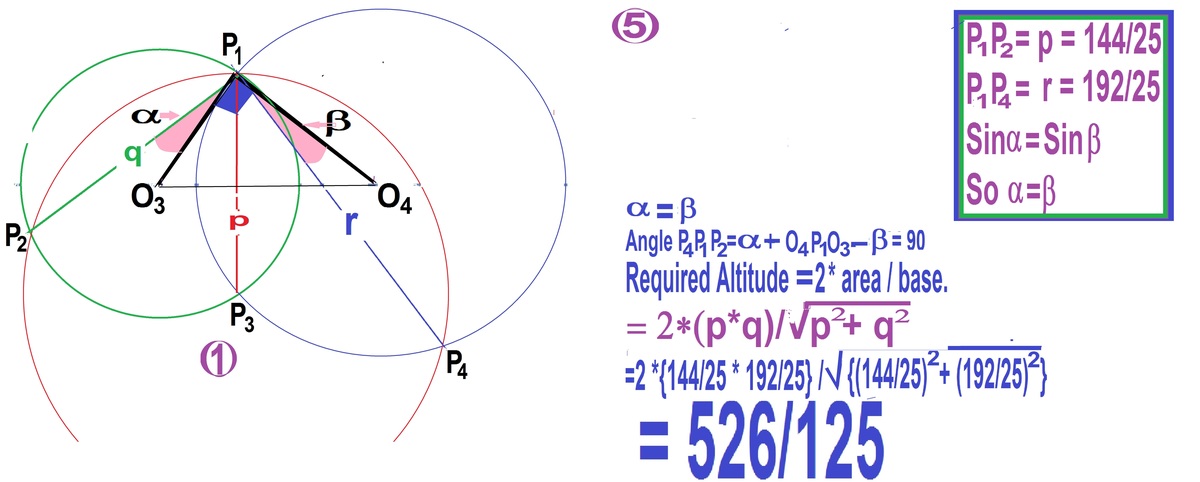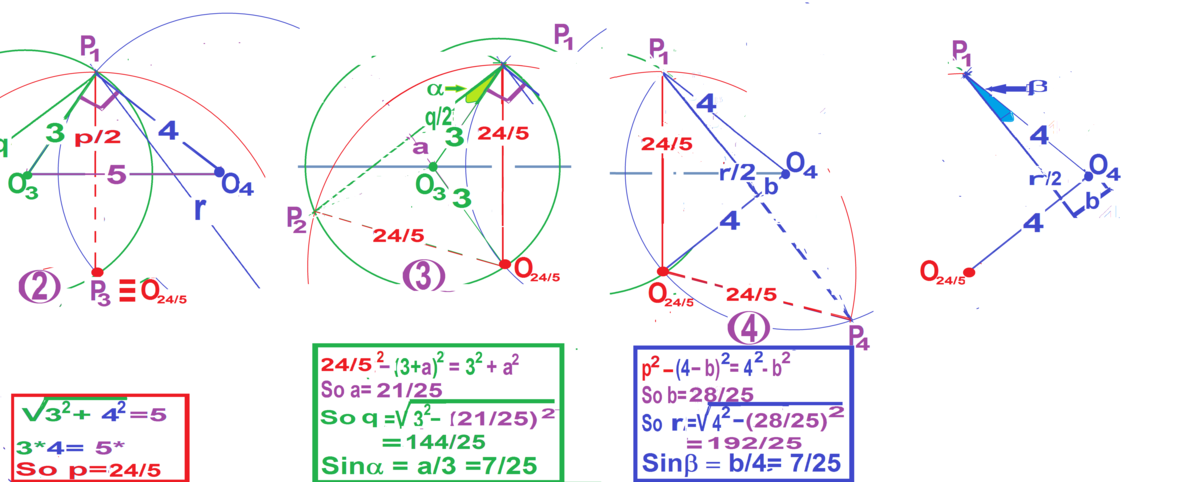Circles, Tangents, And Triangles (Oh My...)
The red circle has radius 3 and the blue circle has radius 4. The tangents to one of their points of intersection, P 1 , are perpendicular.
The green circle is centered at the other point of intersection, P 2 , and passes through P 1 . It also intersects the red and blue circles at P 3 and P 4 , respectively.
What is the length of the altitude from P 1 in triangle P 1 P 3 P 4 ?
This section requires Javascript.
You are seeing this because something didn't load right. We suggest you, (a) try
refreshing the page, (b) enabling javascript if it is disabled on your browser and,
finally, (c)
loading the
non-javascript version of this page
. We're sorry about the hassle.
3 solutions
How do you know that P 2 , P 3 , P 4 are collinear? It's true, but not given as an assumption in the problem.
Log in to reply
< P3P2B = < P4P2C
< P3P2P1 = <BP2P1 - < P3P2B = 90 - < P3P2B
< P4P2P1 = < CP2P1 + < P4P2C = 90 + < P4P2C
adding above two equations
< P3P2P1 + < P4P2P1 = 180 deg. -----> P3 , P2 , P4 are collinear.
Log in to reply
Correct me if I'm wrong, but it seems to me that the first line is true by assuming that P 2 , P 3 , P 4 are collinear (vertical angles). This makes the argument circular.
@ahmad saad Thanks for the great solution. I have 2 suggestions
- Leaving the text outside of the image, so that we can easily make edits to it.
- It would be nice if you used Latex to write the equations, which makes it easier for others to read it. If you're not comfortable doing so, you can request for help and we can get you started on the process.
Log in to reply
Thanks for your great recommendation.
But, I suffer from some pains after open heart surgery and just help myself to forget the pain and to activate my memory from oblivion because of enlarge my age by solving math problems without fatigue as much as possible..
Log in to reply
I'm glad Brilliant is a natural pain reliever for you :) In fact, I'm heard similar stories from other members that by focusing on the Brilliant problems and being so engrossed in them, they are temporarily able to forget the pain that they are in. I wish that the only problems that you have are Brilliant ones :)
For solutions, if you provide enough context, we can help to improve the readability and hence understanding of your solution. For example, It will be great if you can define the points that are used.
I was always wondering where almost all these UNIQUE and BEAUTIFUL solution, with scaled diagrams, came from. Ye, the same person who has beautiful solution even for his physical pain. Salute to you Ahmad Saad.
Beautiful unique solution. We may use the fact that P 1 P 2 P 4 is a 3-4-5 triangle alternately. Up voted.


P l e a s e s e e t h e F i g . F i g . 1 s h o w s t h e p r o b l e m . ∠ O 4 P 1 O 3 i s g i v e n a s 9 0 o . F i g . 2 f i n d s o u t t h e l e n g t h o f P 1 P 3 = p = 5 2 4 F i g . 3 f i n d s o u t t h e l e n g t h o f P 1 P 2 = q = 2 5 1 4 4 , a n d S i n α . F i g . 4 f i n d s o u t t h e l e n g t h o f P 1 P 4 = r = 2 5 1 9 2 , a n d S i n β . F i g . 5 a t t o p r i g h t g e t s t h e a n s w e r .
All three solutions Fig. 2 to Fig. 4 are based on properties of isosceles triangle and its half as a right triangle.
If you are comfortable,use co ordinate geometry to do easily.
Let, P1(0,0) Notice, the centre of the circle of radii 4 lies on the tangent of circle of radii 3 and its centre is C1(4,0) Similarly the centre of the circle of radii 3 lies on C2(0,3)
Note P1P2=24/5 ( easy to evaluate)
It is also the radii of circle with centre P2.
Equation of circle with centre C1,C2,P1 are respectively
1). (x-4)^2+y^2=4^2
2). x^2+(y-3)^2=3^2
3). x^2+y^2=(24/5)^2
Solving 1) and 3 ) we get a value of P3(72/25,-96/25)
Solving 2) and 3) We get P4(-72/25,96/25)
*Equation of P3P4=100x-75y-576=0
Perpendicular from P1(0,0) is
P=|100(0)+(-75)(0)+(-576)|/√(100^2+75^2)
=576/125☺☺☺
Let the blue tangent intersect the red circle at B, let the red tangent intersect the blue circle at C.
Let the center of the red circle be X and the center of the blue circle be Y.
We are given m ∠ B P 1 C = 9 0 ∘ .
Adding the sides and angles as indicated on the diagram, m ∠ 1 + m ∠ 2 = 9 0 ∘ .
Lemma 1: P 1 P 2 B is a right triangle
Since the blue tangent is perpendicular to the red tangent, hence the blue tangent passes through the center of the red circle and P 1 B is the diameter of the red circle. Thus ∠ P 1 P 2 B = 9 0 ∘ .
Lemma 2: B P 2 C is a straight line.
We already have ∠ P 1 P 2 B = 9 0 ∘ . Similarly, ∠ P 1 P 2 C = 9 0 ∘ . Thus, B P 2 C is a straight line.
Lemma 3: P 3 P 2 P 4 is a straight line.
Triangles X P 2 P 1 and X P 2 P 3 are congurent (SSS), hence ∠ P 1 P 2 P 3 = 2 ∠ X P 2 P 1 .
Similarly, Triangles Y P 2 P 1 and Y P 2 P 4 are congurent (SSS), hence ∠ P 1 P 2 P 4 = 2 ∠ Y P 2 P 1 .
Since X P 1 Y P 2 is a kite, hence ∠ X P 2 Y = ∠ X P 1 Y = 9 0 ∘ .
Thus, ∠ P 1 P 2 P 3 + ∠ P 1 P 2 P 4 = 2 ( ∠ X P 2 P 1 + ∠ Y P 2 P 1 ) = 2 ( ∠ X P 2 Y ) = 1 8 0 ∘ .
Lemma 4: P 3 P 1 P 4 is a right triangle.
∠ P 3 P 1 B = ∠ P 3 P 2 B = ∠ P 4 P 2 C = ∠ P 4 P 1 C .
Hence ∠ P 3 P 1 P 4 = ∠ P 3 P 1 B + ∠ B P 1 P 4 = ∠ P 4 P 1 C + ∠ B P 1 P 4 = ∠ B P 1 C = 9 0 ∘ .
Finally, we are ready to do the calculations:
m P 1 P 2 = m P 1 B ⋅ m P 1 C / m B C = 6 ⋅ 8 / 1 0 = 5 2 4
sin ( ∠ 1 ) = cos ( ∠ 2 ) = 5 3
cos ( ∠ 1 ) = 5 4
m P 1 P 3 = 2 ⋅ m P 1 P 2 cos ( ∠ 2 ) = 2 5 1 4 4
m P 1 P 4 = 2 ⋅ m P 1 P 2 cos ( ∠ 1 ) = 2 5 1 9 2
m P 3 P 4 = 2 ⋅ m P 1 P 2 = 5 4 8
Then the altitude of the triangle P 3 P 1 P 4 is m P 1 H = m P 1 P 3 ⋅ m P 1 P 4 / m P 3 P 4 = 1 2 5 5 7 6 .